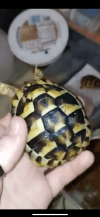HoosierTort
Active Member
A friend hit me up this morning with a pic and question on an 8 month old eastern Hermann’s.
Has anyone ever seen folding like this from the plastron during growth? Husbandry is on par and all other hatchlings are growing normal.
Any thoughts? Almost like reverse kyphosis or something genetic?
Has anyone ever seen folding like this from the plastron during growth? Husbandry is on par and all other hatchlings are growing normal.
Any thoughts? Almost like reverse kyphosis or something genetic?


